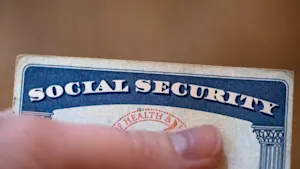Millennial Money: Is meal kit delivery still worth the cost?
Whether the meal kits are worth the cost depends on what’s important to you and what you would be spending otherwise on food. Here are some factors to consider when you’re deciding whether to start - or continue - a meal kit subscription.
Share:
More Stories
0:34

Amazon cuts 14,000 corporate jobs as spending on artificial intelligence accelerates
4ds ago1:46

The Cost Of: Halloween decorations & parties
5ds ago1:46

The Cost Of: Spooky season spending up for decorations and Halloween parties
5ds ago0:26

Social Security recipients get 2.8% cost-of-living boost in 2026, average of $56 per month
8ds ago0:28

Toys 'R' Us is opening a new flagship store here on Long Island
10ds ago1:37

The Cost Of: Halloween costumes
12ds ago0:34

Amazon cuts 14,000 corporate jobs as spending on artificial intelligence accelerates
4ds ago1:46

The Cost Of: Halloween decorations & parties
5ds ago1:46

The Cost Of: Spooky season spending up for decorations and Halloween parties
5ds ago0:26

Social Security recipients get 2.8% cost-of-living boost in 2026, average of $56 per month
8ds ago0:28

Toys 'R' Us is opening a new flagship store here on Long Island
10ds ago1:37

The Cost Of: Halloween costumes
12ds ago
Meal kit subscriptions boomed in popularity in 2020, when more people were staying home and cooking than going out to eat during the beginning of the COVID-19 pandemic. Companies like HelloFresh, Blue Apron and EveryPlate catered to customers looking for healthy meals with more variety, made with pre-portioned ingredients shipped to their door.
But now that restaurants and supermarkets are back to business as usual, some meal kit users are wondering if their subscription is still worth the cost - especially after the promotional offers are gone. Meal kit companies are known to offer dramatic discounts on their plans for new customers, including dozens of free meals, or over 50% off the full price for first-time subscribers.
Excluding promotions, meals generally run between $6 to $12 per serving , putting the cost on par with some takeout options. And with most meal kit subscriptions covering just four to six meals a week, customers still need to grocery shop for their other two daily meals.
Whether the meal kits are worth the cost depends on what’s important to you and what you would be spending otherwise on food. Here are some factors to consider when you’re deciding whether to start - or continue - a meal kit subscription.
HOW MUCH WOULD YOU OTHERWISE SPEND ON FOOD?
For some customers, the most important factor in deciding whether to use a meal kit is the price. A subscription may cost more or less than you would typically spend on ingredients, depending on your budget for groceries and dining out, and household size.
“The intro offer pricing was equivalent to my usual weekly grocery budget, but a full-price box wasn’t,” says Nadia Russell, a health care analyst. She enjoyed the convenience and variety her subscription offered, but she canceled after the promotional period due to the cost increase.
“I could spend the same amount at the grocery store for a week’s worth of groceries,” says Emily Bird, an administrator for a music distribution company, about the cost of a weekly meal kit package. She, too, took advantage of a popular meal kit’s promotional offer but chose to cancel the subscription after the first few weeks.
But if you’d otherwise be purchasing takeout or going to a restaurant, a meal kit could be a cheaper option. It could also be a more appealing option for a larger household: Most services offer a discount for a higher number of servings.
Madisenne Berry, a massage therapist, subscribed to an ingredient-based meal kit to cook weeknight dinners for her three-person household.
“It was definitely cheaper than buying groceries at the grocery store every week,” she says, noting that she didn’t cancel for cost-related reasons.
HOW MUCH ARE YOU WILLING TO PAY FOR CONVENIENCE?
Meal kits can be cost-effective in less concrete ways. They reduce the time and energy needed to plan meals and shop for groceries, which can hold you back from getting creative in the kitchen.
“I like to cook and try new recipes,” says Christina McNichol, a full-time nanny. “It’s way more expensive to try to make elaborate recipes when you have to buy all the ingredients separately; with a meal kit, I could pick my meals ahead of time and get the exact amount I needed.”
Others benefit from the convenience of having pre-portioned ingredients delivered - especially if it’s difficult to get groceries in person.
“I moved to a new city this year and didn’t have a car, so I wasn’t able to access groceries easily,” says Russell, the health care analyst. “Using a meal kit service for the first few weeks allowed me to cook a variety of meals at home without relying on someone else to help me get to the store.”
If grocery shopping is too time-consuming or difficult to access, a meal kit subscription can help ensure you’re not sacrificing the variety or nutritional value of your food in exchange for convenience.
HOW MUCH ARE YOU WILLING TO PAY FOR VARIETY?
Cooking at home - without a meal kit - typically involves finding creative ways to reuse available ingredients throughout the week, resulting in meals with repeating elements or leftovers to limit food waste (think a fish and rice dinner, followed by fish tacos the next day). With meal kits, you can get a wider variety of meals without ending up with leftovers or extra items, since ingredients are divided into smaller amounts than what you’d find in a grocery store.
“Having the exact right amount of each ingredient was a big plus,” Bird says. “Some items, like a herb garnish or a spoonful of yogurt for a sauce, can’t be purchased in a single serving at a grocery store. Getting the perfect portion encouraged me to make recipes I wouldn’t usually try.”
“I definitely wasted less food,” says McNichol. “Some of the recipes included ingredients I don’t usually cook with, which would typically go bad if I couldn’t use them for another meal.”
If you’re happy with your usual home-cooked rotation of meals and leftovers, paying more for a varied dinner menu might not make sense. But it could be worth the extra cost - and perhaps even more cost-effective - if you’re itching to try new recipes but don’t want to buy a cartful of ingredients you haven’t used before and might not use again.
________________________
This column was provided to The Associated Press by the personal finance website NerdWallet. Dalia Ramirez is a writer at NerdWallet. Email: dramireznerdwallet.com.
More from News 12
1:33

The Real Deal: How to handle the New York housing market
1:42

The Real Deal: Calculating your commuting costs
1:20

Real Deal: Holiday spending means 2nd most expensive budget event of the year
1:24

The Real Deal: Shopping apps can help you cash in during holiday spending
1:28

Real Deal: Coffee, eggs, heat prices all rising in New York
1:08
